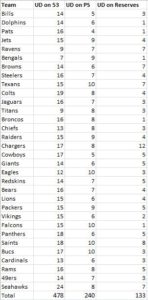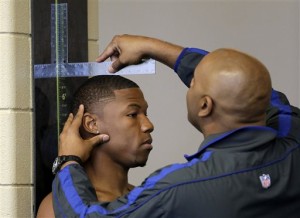
By Justin VanFulpen
With the 2016 NFL Draft in the books here is a look at the average height, weight, 40, Vertical Jump, Short shuttle, and 3 cone drill by position of players that were drafted.
QBs: 6037 226 – 4.84 (40) – 30.9’’ (Vertical) – 4.31 (20 yard shuttle) – 7.15 (3-Cone)
Fastest 40 – 4.78 (Hackenburg & Hogan)
Highest Vertical – 36’’ (Lynch & Jones)
Fastest Short Shuttle – 4.15 (Wentz)
3 Cone – 6.86 (Wentz)
RBs: 5112 214 – 4.49 (40) – 35.2’’ (Vertical) – 4.28 (20 yard shuttle) – 7.04 (3-Cone)
Fastest 40 – 4.31 (Drake)
Highest Vertical – 41.5’’ (Lasco)
Fastest Short Shuttle – 4.20 (Taylor & DeAndre Washington)
3 Cone – 6.83 (Smallwood)
FBs: 6008 233 – 4.73 (40) – 35.3’’ (Vertical) – 4.25 (20 yard shuttle) – 7.20 (3-Cone)
Fastest 40 – 4.60 (Vitale)
Highest Vertical – 38.5’’ (Vitale)
Fastest Short Shuttle – 4.12 (Vitale)
3 Cone – 7.12 (Vitale)
WRs: 6004 199 – 4.48 (40) – 35.2’’ (Vertical) – 4.24 (20 yard shuttle) – 6.92 (3-Cone)
Fastest 40 – 4.29 (Hill)
Highest Vertical – 41’’ (Doctson & Shepard)
Fastest Short Shuttle – 4.06 (Hill)
3 Cone – 6.53 (Hill)
TEs: 6045 252 – 4.75 (40) – 32.9’’ (Vertical) – 4.27 (20 yard shuttle) – 7.00 (3-Cone)
Fastest 40 – 4.64 (Adams)
Highest Vertical – 40’’ (DeValve)
Fastest Short Shuttle – 4.15 (DeValve)
3 Cone – 6.88 (Adams)
OTs: 6055 310 – 5.17 (40) – 28.2’’ (Vertical) – 4.73 (20 yard shuttle) – 7.90 (3-Cone)
Fastest 40 – 4.94 (Spriggs)
Highest Vertical – 32.5’’ (Ifedi)
Fastest Short Shuttle – 4.44 (Spriggs)
3 Cone – 7.63 (Conklin)
OGs: 6043 304 – 5.19 (40) – 27.3’’ (Vertical) – 4.72 (20 yard shuttle) – 7.72 (3-Cone)
Fastest 40 – 4.95 (Thuney)
Highest Vertical – 33’’ (McGovern)
Fastest Short Shuttle – 4.54 (Thuney)
3 Cone – 7.32 (Whitehair)
Cs: 6037 301 – 5.19 (40) – 27.5’’ (Vertical) – 4.64 (20 yard shuttle) – 7.54 (3-Cone)
Fastest 40 – 5.13 (Glasgow)
Highest Vertical – 30’’ (Kelly)
Fastest Short Shuttle – 4.52 (Seumalo)
3 Cone – 7.40 (Seumalo)
DEs: 6044 273 – 4.83 (40) – 32.7’’ (Vertical) – 4.37 (20 yard shuttle) – 7.29 (3-Cone)
Fastest 40 – 4.59 (Tapper)
Highest Vertical – 37.5’’ (Holmes)
Fastest Short Shuttle – 4.00 (McCalister)
3 Cone – 6.89 (Bosa)
DTs: 6028 304 – 5.07 (40) – 28.5’’ (Vertical) – 4.65 (20 yard shuttle) – 7.29 (3-Cone)
Fastest 40 – 4.69 (Ridgeway)
Highest Vertical – 35’’ (Nkemdiche)
Fastest Short Shuttle – 4.50 (Day)
3 Cone – 7.25 (Onyemata)
OLBs: 6020 241 – 4.66 (40) – 34.1’’ (Vertical) – 4.36 (20 yard shuttle) – 7.18 (3-Cone)
Fastest 40 – 4.42 (Weatherly)
Highest Vertical – 41’’ (Nicolas)
Fastest Short Shuttle – 4.20 (Lee & Correa)
3 Cone – 6.65 (James)
ILBs: 6010 240 – 4.72 (40) – 32.4’’ (Vertical) – 4.33 (20 yard shuttle) – 7.08 (3-Cone)
Fastest 40 – 4.57 (Walker)
Highest Vertical – 37.5’’ (Walker)
Fastest Short Shuttle – 4.00 (Vigil)
3 Cone – 6.73 (Vigil)
CBs: 5114 194 – 4.47 (40) – 35.8’’ (Vertical) – 4.21 (20 yard shuttle) – 7.00 (3-Cone)
Fastest 40 – 4.33 (Brown)
Highest Vertical – 41.5’’ (Ramsey & Reed)
Fastest Short Shuttle – 3.98 (Hargreaves)
3 Cone – 6.60 (Caldwell)
Ss: 6004 204 – 4.56 (40) – 36.1’’ (Vertical) – 4.21 (20 yard shuttle) – (3-Cone)
Fastest 40 – 4.42 (Grugier-Hill)
Highest Vertical – 40.5’’ (Nicolas)
Fastest Short Shuttle – 4.20 (Frazier & Fejedelem)
3 Cone – 6.58 (Simmons)







